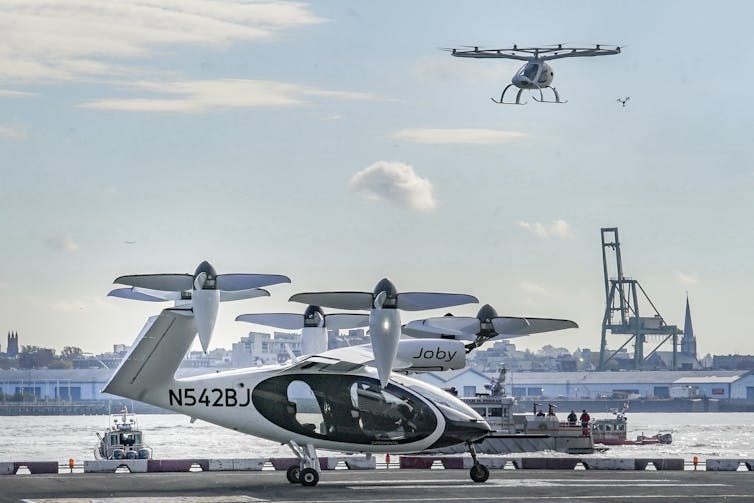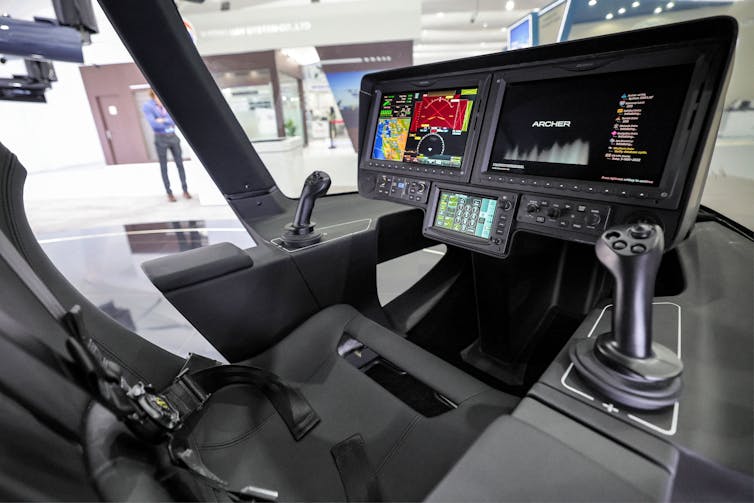Imagine a future with nearly silent air taxis flying above traffic jams and navigating between skyscrapers and suburban droneports. Transportation arrives at the touch of your smartphone and with minimal environmental impact.
This isn’t just science fiction. United Airlines has plans for these futuristic electric air taxis in Chicago and New York. The U.S. military is already experimenting with them. And one company has a contract to launch an air taxi service in Dubai as early as 2025. Another company hopes to defy expectations and fly participants at the 2024 Paris Olympics.
Backed by billions of dollars in venture capital and established aerospace giants that include Boeing and Airbus, startups across the world such as Joby, Archer, Wisk and Lilium are spearheading this technological revolution, developing electric vertical takeoff and landing (eVTOL) aircraft that could transform the way we travel.
Electric aviation promises to alleviate urban congestion, open up rural areas to emergency deliveries, slash carbon emissions and offer a quieter, more accessible form of short-distance air travel.

But the quest to make these electric aircraft ubiquitous across the globe instead of just playthings for the rich is far from a given. Following the industry as executive director of the Oklahoma Aerospace Institute for Research and Education provides a view of the state of the industry. Like all great promised paradigm shifts, numerous challenges loom – technical hurdles, regulatory mazes, the crucial battle for public acceptance and perhaps physics itself.
Why electrify aviation?
Fixed somewhere between George Jetson’s flying car and the gritty taxi from “The Fifth Element,” the allure of electric aviation extends beyond gee-whiz novelty. It is rooted in its potential to offer efficient, eco-friendly alternatives to ground transportation, particularly in congested cities or hard-to-reach rural regions.
While small electric planes are already flying in a few countries, eVTOLs are designed for shorter hops – the kind a helicopter might make today, only more cheaply and with less impact on the environment. The eVTOL maker Joby purchased Uber Air to someday pair the company’s air taxis with Uber’s ride-hailing technology.
In the near term, once eVTOLs are certified to fly as commercial operations, they are likely to serve specific, high-demand routes that bypass road traffic. An example is United Airlines’ plan to test Archer’s eVTOLs on short hops from Chicago to O'Hare International Airport and Manhattan to Newark Liberty International Airport.
While some applications initially might be restricted to military or emergency use, the goal of the industry is widespread civil adoption, marking a significant step toward a future of cleaner urban mobility.
The challenge of battery physics
One of the most significant technical challenges facing electric air taxis is the limitations of current battery technology.
Today’s batteries have made significant advances in the past decade, but they don’t match the energy density of traditional hydrocarbon fuels currently used in aircraft. This shortcoming means that electric air taxis cannot yet achieve the same range as their fossil-fueled counterparts, limiting their operational scope and viability for long-haul flights. Current capabilities still fall short of traditional transportation. However, with ranges from dozens of miles to over 100 miles, eVTOL batteries provide sufficient range for intracity hops.
The quest for batteries that offer higher energy densities, faster charging times and longer life cycles is central to unlocking the full potential of electric aviation.
While researchers are working to close this gap, hydrogen presents a promising alternative, boasting a higher energy density and emitting only water vapor. However, hydrogen’s potential is tempered by significant hurdles related to safe storage and infrastructure capable of supporting hydrogen-fueled aviation. That presents a complex and expensive logistics challenge.
And, of course, there’s the specter of the last major hydrogen-powered aircraft. The Hindenburg airship caught fire in 1937, but it still looms large in the minds of many Americans.
Regulatory hurdles
Establishing a “4D highways in the sky” will require comprehensive rules that encompass everything from vehicle safety to air traffic management. For the time being, the U.S. Federal Aviation Administration is requiring that air taxis include pilots serving in a traditional role. This underscores the transitional phase of integrating these vehicles into airspace, highlighting the gap between current capabilities and the vision of fully autonomous flights.
The journey toward autonomous urban air travel is fraught with more complexities, including the establishment of standards for vehicle operation, pilot certification and air traffic control. While eVTOLs have flown hundreds of test flights, there have also been safety concerns after prominent crashes involving propeller blades failing on one in 2022 and the crash of another in 2023. Both were being flown remotely at the time.
The question of who will manage these new airways remains an open discussion – national aviation authorities such as the FAA, state agencies, local municipalities or some combination thereof.
Creating the future
In the long term, the vision for electric air taxis aligns with a future where autonomous vehicles ply the urban skies, akin to scenes from “Back to the Future.” This future, however, not only requires technological leaps in automation and battery efficiency but also a societal shift in how people perceive and accept the role of autonomous vehicles, both cars and aircraft, in their daily lives. Safety is still an issue with autonomous vehicles on the ground.

The successful integration of electric air taxis into urban and rural environments hinges on their ability to offer safe, reliable and cost-effective transportation.
As these vehicles overcome the industry’s many hurdles, and regulations evolve to support their operation in the years ahead, I believe we could witness a profound transformation in air mobility. The skies offer a new layer of connectivity, reshaping cities and how we navigate them.

